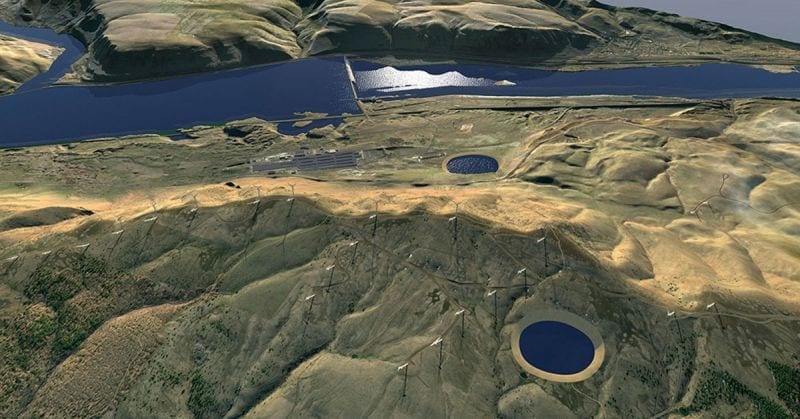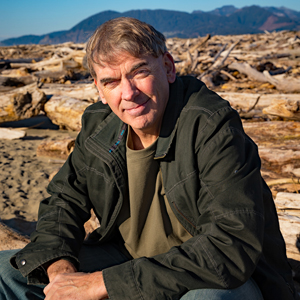The Gorge pumped-hydro project will bring jobs and help grid managers increase energy storage capacity

Powerful perspective: This to-scale rendering of the proposed Goldendale Energy Storage Project shows existing wind turbines, high-voltage transmission lines, John Day Dam and former Golden Northwest Aluminum smelter. Image courtesy of Rye Development
By Les Perkins. April 29, 2021. This winter’s weather-related blackouts in Texas, last summer’s rolling blackouts in California, the threat of emergency power shutoffs during our wildfire season—these are all reminders of how fragile our power grids can be. Our national electric grid—which is a huge network of power plants, transmission lines and distribution centers—is undergoing vast changes due to the need to update aging infrastructure and meet a growing demand for emissions-free electricity.
As the Pacific Northwest region’s utilities add more renewable energy to the electric grid, they face a big challenge: how to store excess solar and wind energy so we can use it when we need it most?
Energy storage has rapidly emerged as an essential component to a low-carbon energy future.
Many utilities are looking at both customer and utility-scale battery installations to help them balance supply and demand. Yet there is another reliable, mature technology that can help grid managers increase storage capacity while at the same time generating clean power. Known as pumped storage hydro, it’s the oldest and largest form of energy storage and is widely recognized as the cheapest way to store energy with a very long lifespan and little loss of efficiency over time.
One site in Klickitat County—home to a former aluminum smelter—has long been considered ideal for pumped storage hydro because of its geology, geography, proximity to renewable energy developments and proximity to existing high-voltage power lines.
The proposed Goldendale Energy Storage Project would generate as much as 1,200 megawatts of clean electricity on demand while also storing the region’s abundant wind and solar electricity.


How it works: Transferring water between upper and lower reservoirs generates power. The project would need 360 acre-feet of water each year to replenish water lost through evaporation. Image from Washington Department of Ecology
The Goldendale Project is a “closed-loop” pumped-storage hydro facility with an upper and lower reservoir where water is recirculated between the two reservoirs. During times of peak sun and/or high winds the plant uses surplus energy to pump water from the lower reservoir to the upper reservoir. Then, during peak demand hours, the water is returned by gravity to the lower reservoir passing through turbine generators that generate electricity.
This proven storage technology could be the future of meeting peak electricity demands. Currently, peak loads are typically served by gas-powered generation.
In addition to the environmental benefits, there are huge economic benefits. The over $2 billion project is expected to create more than 3,000 family wage jobs during its four-year construction period, and another 50 to 70 permanent operational jobs.
Over the last 15 years, the Gorge has become a hub for utility-scale renewable energy projects, which have created well-paying family-wage jobs, generated millions in annual tax revenue for counties, and inspired a nationally recognized renewable energy technology program at Columbia Gorge Community College.
The Goldendale Energy Storage Project is important for the Gorge economy and the Northwest power grid but is also pivotal in our quest for a low-carbon energy future. As utilities and their customers consider how to meet future power needs, it’s critical that they consider reliable, proven technology like the Goldendale Storage Project.
The views expressed in this article belong solely to its author and do not reflect the opinions of anyone else associated with Columbia Insight.
Les Perkins is the general manager of Farmers Irrigation District, a Hood River County Commissioner, the board chair of the Community Renewable Energy Association and a member of the Hood River Energy Council. The opinions expressed in this article are those of the author and do not necessarily reflect the organizations he represents.







Our quest for every-increasing and growing sources of energy may be unsustainable. Large-scale energy projects may cause more environmental damage that we can’t afford. Still, there may be a place for storage projects. The Goldendale project, however, is unacceptable for it’s impacts on cultural resources (different from archaeological resources) and on an environmental already damaged by extensive wind farm development. The carrot of 3,000 family wage jobs is not as simple as it seems, either. Our power grids are certainly fragile and vulnerable, but upgrades to what we have are in order (witness the Texas disaster), and the obvious answer is not to continue to build large projects that place more demands on that grid, but to build small dispersed power generation close to use.
Given the dramatic changes in western energy markets over the past decade, there are lots of pressing questions Klickitat County residents should be asking before green lighting this project. One is cost: $3 billion over 10 years before it ever produces a single megawatt of power. Next question might be, what will happen to the market for electricity over the coming decade? Currently the region is sitting on a glut of electricity that is forecast to persist for at least that interval of time. Electricity prices will remain flat or decline, as they have been for the past decade. What does this mean for pumped storage that relies on a slim margin of profit between the cost of pumping water uphill and sending back downhill through turbines to generate power? This project will rely on federal hydropower to move water up slope. Unfortunately, the cost of that power is already more expensive than wind, solar or gas powered turbines. Ten years ago, California’s energy policy incentivized the construction of both rooftop and utility-scale solar. Since then, 12,000 megawatts of solar has been installed in the state, much of which has been built with storage, all priced at roughly two-thirds of the cost per megawatt of what we pay for federal hydropower. Simply stated, the input costs are too high for this project to be profitable. Storage is certainly a critical piece of our energy future, but pumped storage at this location will not pan out. Solar plus battery storage, in the form of a product like Tesla’s megapacks, could be built out in less than a year for far less than $3 billion. That option, unfortunately, does not currently exist, since the Klickitat County Commissioners have voted to place a moratorium on utility-scale solar.
And then there’s the water. Pumped storage is moving forward in the Klamath Basin using groundwater – new pressure on an already overallocated system that feeds wetlands, wildlife refuges and streamflows. Where water is already severly overallocated, or where existing legal mechanisms have to be spercially reconfigured to make pumped storage possible, pumped storage proposals should be met with a lot of skepticism.
Many of these proposals have little to do with “storing excess wind or solar energy.” Rather, they are cash registers that allow their owners to profit by playing the power market in a form of water intensive arbitrage.
Typically I am all for sustainable energy, but this just makes little to no sense on two levels. Environmentally, it is SO invasive. It is just a ridiculous amount of environmental disturbance to build this pond atop a mountain. Secondly, $2 BILLION(?!?!) is a sum of money that could be put to about 500 better uses in this area than a water storage pond in this one mountain. Nope-nope-nope.